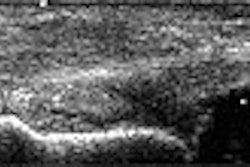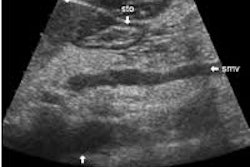Rotator cuff disease is the most common cause of shoulder pain, but the natural history of tears is unknown because patients already have symptoms at presentation. While previous research has confirmed that asymptomatic rotator cuff tears exist and that their prevalence increases with age, the significance of such tears is relatively unknown, said Dr. Sharlene Teefey of the Mallinckrodt Institute of Radiology (MIR) in St. Louis.
To compare the morphology and incidence of cuff disease in people with unilateral painful shoulders, an MIR research team performed a computer search for shoulder sonogram reports between June 1996 and March 2002. Teefey presented the results at the 2002 RSNA meeting in Chicago.
Of the 2,356 reports found in the search, 588 were from patients presenting with unilateral shoulder pain. These included 212 patients with bilateral intact cuffs, 191 patients with unilateral tears, and 185 with bilateral tears. The study team then looked for associations by studying the data for criteria including age, cuff thickness, tear size, symptoms, and incidence.
Cuff disease increased with average age (patients with no tear: 48.7 years; patients with unilateral tear: 58.7 years; and patients with bilateral tears: 67.8 years), and logistical regression demonstrated a 50% likelihood of bilateral tears after age 66, Teefey said.
"We found that unilateral tears tend to occur in a slightly younger age group, and bilateral tears in older patients," she said. "Cuff tears are rare, as has been shown, before 50."
When a patient had a full-thickness tear on the symptomatic side, the researchers found there was a 35.5% prevalence of a contralateral asymptomatic tear, Teefey said. In contrast, symptomatic normal or partial-thickness tears had only a 0.5% or 4.3% incidence of contralateral asymptomatic tear, respectively.
"We found that in patients with bilateral tears that the symptomatic tear was larger than the asymptomatic tear by approximately 25%," she said.
Patients with bilateral tears had a median tear width of 23 mm on the symptomatic side, compared to a median tear width of 15 mm in patients with or without pain from unilateral tears. Sixty-five percent of the painful tears were on the side of the patient's dominant hand, Teefey said. Intact cuffs had an average thickness of 4.7 mm, and there was no significant relationship with age, gender, or symptoms.
"Intact cuffs did not show an age-related decrease in thickness," she said.
Since the prevalence of an asymptomatic contralateral tear was highest in patients with a full-thickness symptomatic tear, the data suggests that bilateral shoulder ultrasound should be performed in this patient population, she said.
By Erik L. RidleyAuntMinnie.com staff writer
April 2, 2003
Related Reading
MRI of the Shoulder, January 29, 2003
Mallinckrodt radiologist gives high marks to musculoskeletal ultrasound, February 24, 2002
MRI shoulders burden of skiers' rotator cuff tears, February 23, 2002
Copyright © 2003 AuntMinnie.com




















